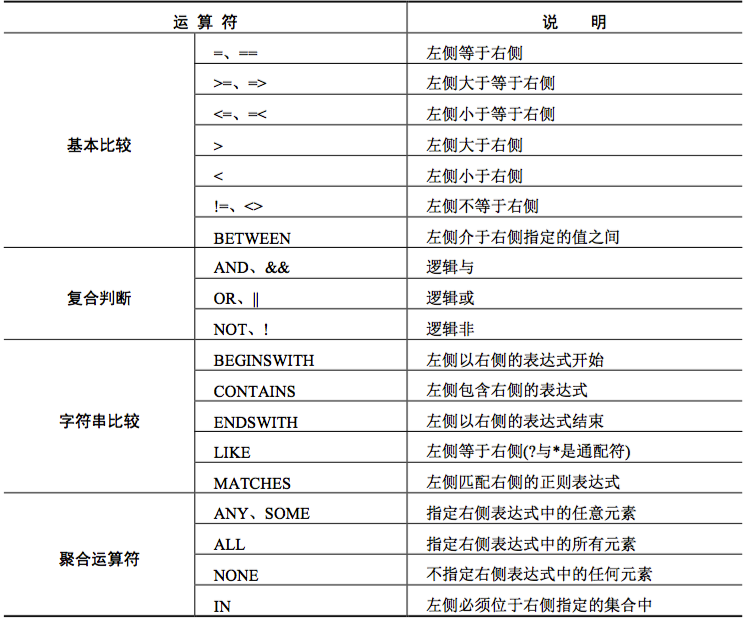NSPredicate是什么?
NSPredicate 是预测的意思 但是我们常翻译成谓词
它可以干什么?
使用NSPredicate可以定义模糊查询条件 根据一定的条件 我们就可以从一个数组中快速找出 符合一定条件的元素对象
本次的示范我们沿用上次讲的 NSSortDescriptor 的使用 里面的代码 我们只需要稍微的修改一下 导航栏右边的按钮 为‘搜索年龄大于20的对象’ 然后再把点击左上角按钮的业务代码修改为如下:
- (IBAction)sortAge:(id)sender { NSPredicate *predicate = [NSPredicate predicateWithFormat:@"age>20"]; //创建NSPredicate对象 并定义查询条件 self.datas = [[self.datas filteredArrayUsingPredicate:predicate] mutableCopy]; //使用数组的filteredArrayUsingPredicate方法 获取符合我们指定条件的对象
[self.tableView reloadData];
}
这个时候我们点击左上角的按钮 就可以查询出数组里面 年龄大于20的对象
除了 > 号之外 我们还可以用IN 查询两个数组的交集
我们新建一个程序 来测试IN 的用法 我们在ViewDidload方法里面 写入如下代码:
- (void)viewDidLoad { [super viewDidLoad]; NSArray *array1 = [NSArray arrayWithObjects:@1,@2,@3,@4,@5,@6,@7,@8, nil]; NSArray *array2 = [NSArray arrayWithObjects:@4,@6, nil]; NSPredicate *predicate = [NSPredicate predicateWithFormat:@"SELF in%@",array2]; //SELF 代表本身 IN可以大写也可以小写
NSArray *temp = [array1 filteredArrayUsingPredicate:predicate]; //表示获取 array2 和 array1中的交集
NSLog(@"temp ==== %@",temp); }
运行 打印结果为:
temp ====
(
4,
6
)
可以看到这两个数组的交集就是4和6 因为这两个数组中 都有4和6 这个元素
同时除了IN 之外 BETWEEN可以获取一定范围的值 示例代码如下:
- (void)viewDidLoad { [super viewDidLoad];
NSArray *array1 = [NSArray arrayWithObjects:@100,@20,@3,@4,@4,@6,@7,@1, nil];
NSPredicate *predicate = [NSPredicate predicateWithFormat:@"SELF BETWEEN{1,20}"]; NSArray *temp = [array1 filteredArrayUsingPredicate:predicate]; NSLog(@"temp ==== %@",temp); }
上面的代码表示找出 值在1到20范围类的值包括首尾
打印结果如下:
temp ====
(
20,
3,
4,
4,
6,
7,
1
)
当然除了上面介绍的两个用法之外 还有其他的比较运算符>,<,==,>=,<=,!=
这里以等于号==为例:
- (void)viewDidLoad { [super viewDidLoad]; NSArray *array1 = [NSArray arrayWithObjects:@100,@20,@3,@4,@4,@6,@7,@1, nil]; NSPredicate *predicate = [NSPredicate predicateWithFormat:@"SELF ==6"]; NSArray *temp = [array1 filteredArrayUsingPredicate:predicate]; NSLog(@"temp ==== %@",temp); }
打印结果如下:
temp ====
(
6
)
同时还有以下与字符串操作相关的关键词 :
BEGINSWITH :以某个字符串开头
ENDSWITH :以某个字符串结尾
CONTAINS :是否包含某个字符串
同时这三个关键词后面还可以跟上一些格式符号 如:BEGINSWITH[cd] c表示不区分大小写 d表示不区分发音符号 cd就可以表示即不区分大小写 也不区分发音符号
- (void)viewDidLoad { [super viewDidLoad]; NSArray *array1 = [NSArray arrayWithObjects:@"jack",@"anne",@"reserved",@"control" ,@"type",@"soure",@"version",nil]; //查询出包含e这个字符的字符串 NSPredicate *predicate = [NSPredicate predicateWithFormat:@"SELF CONTAINS[cd] 'E' "]; NSArray *temp = [array1 filteredArrayUsingPredicate:predicate]; NSLog(@"temp ==== %@",temp); }
打印结果如下:
temp ====
(
anne,
reserved,
type,
soure,
version
)
- (void)viewDidLoad { [super viewDidLoad]; NSArray *array1 = [NSArray arrayWithObjects:@"jack",@"anne",@"reserved",@"control" ,@"type",@"soure",@"version",nil]; //查询出以a这个字符开头的字符串 NSPredicate *predicate = [NSPredicate predicateWithFormat:@"SELF BEGINSWITH[cd] 'a' "]; NSArray *temp = [array1 filteredArrayUsingPredicate:predicate]; NSLog(@"temp ==== %@",temp); }
打印结果如下:
temp ====
(
anne
)
- (void)viewDidLoad { [super viewDidLoad]; NSArray *array1 = [NSArray arrayWithObjects:@"jack",@"anne",@"reserved",@"control" ,@"type",@"soure",@"version",nil]; //查询出以e这个字符结尾的字符串 NSPredicate *predicate = [NSPredicate predicateWithFormat:@"SELF ENDSWITH[cd] 'e' "]; NSArray *temp = [array1 filteredArrayUsingPredicate:predicate]; NSLog(@"temp ==== %@",temp); }
打印结果如下:
temp ====
(
anne,
type,
soure
)
还有一个你可能会用到的关键字 LIKE 他后面也可以写[cd]格式符号
- (void)viewDidLoad { [super viewDidLoad]; NSArray *array1 = [NSArray arrayWithObjects:@"jack",@"anne",@"reserved",@"control" ,@"type",@"soure",@"version",nil]; //查询出包含e这个字符的字符串 NSPredicate *predicate = [NSPredicate predicateWithFormat:@"SELF like[cd] '*e*' "]; //*表示通配符 NSArray *temp = [array1 filteredArrayUsingPredicate:predicate]; NSLog(@"temp ==== %@",temp); }
打印结果如下:
temp ====
(
anne,
reserved,
type,
soure,
version
)
最后附上所有的相关的条件字符
